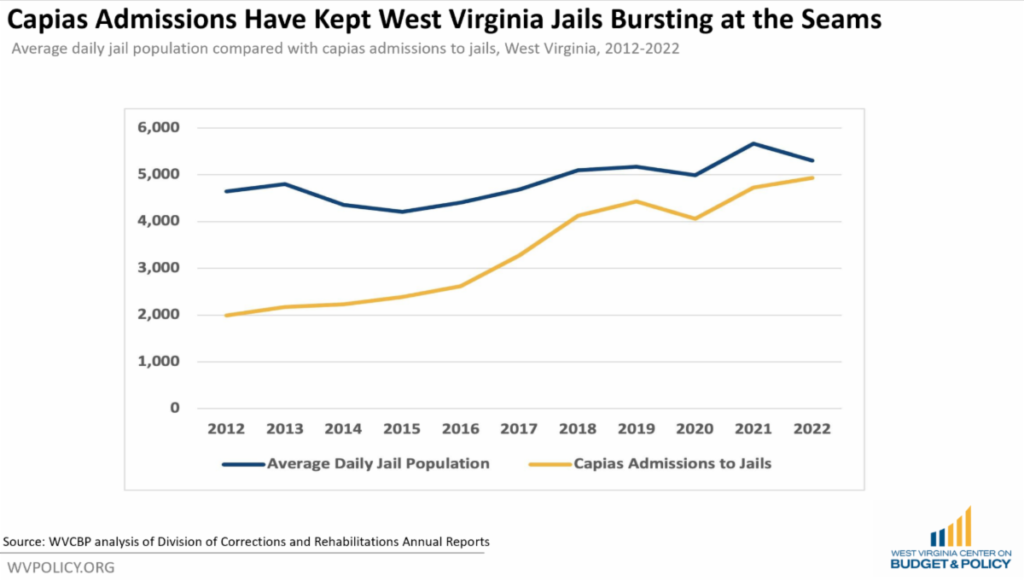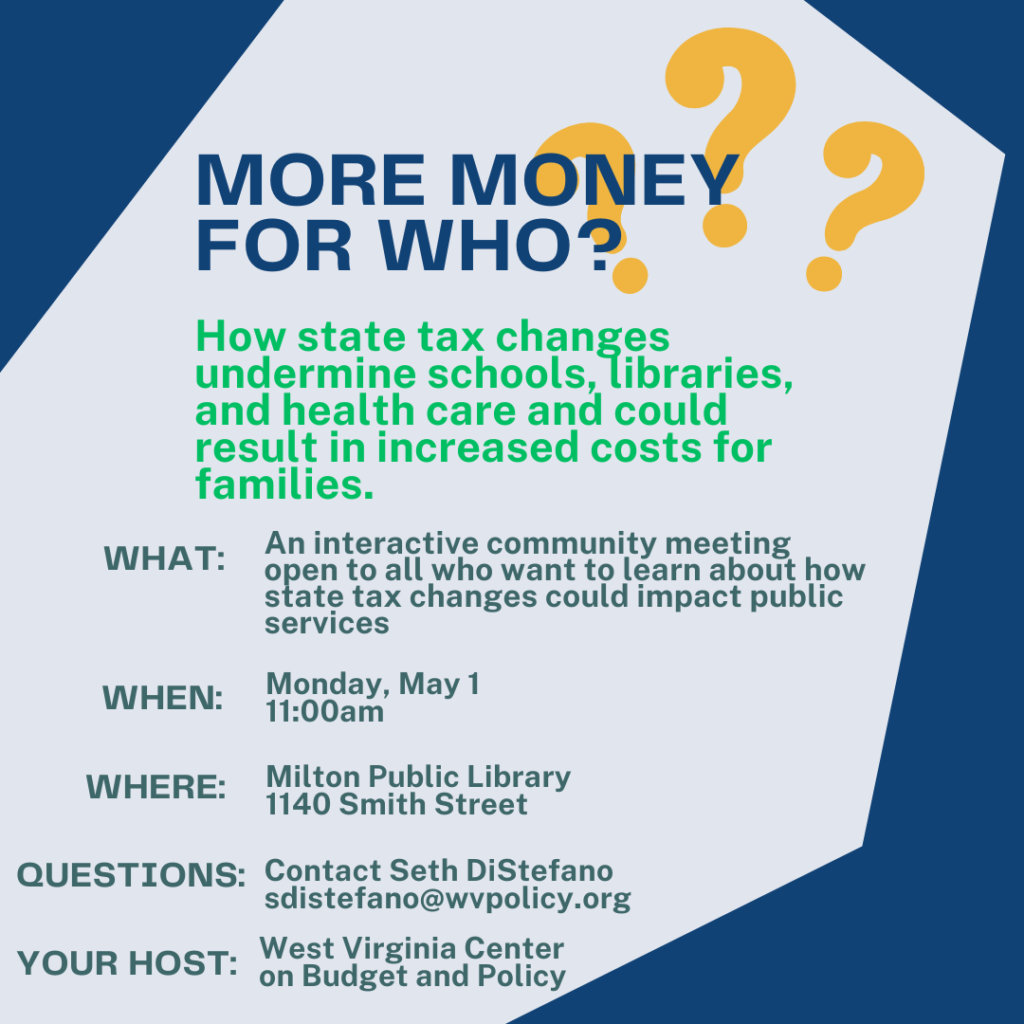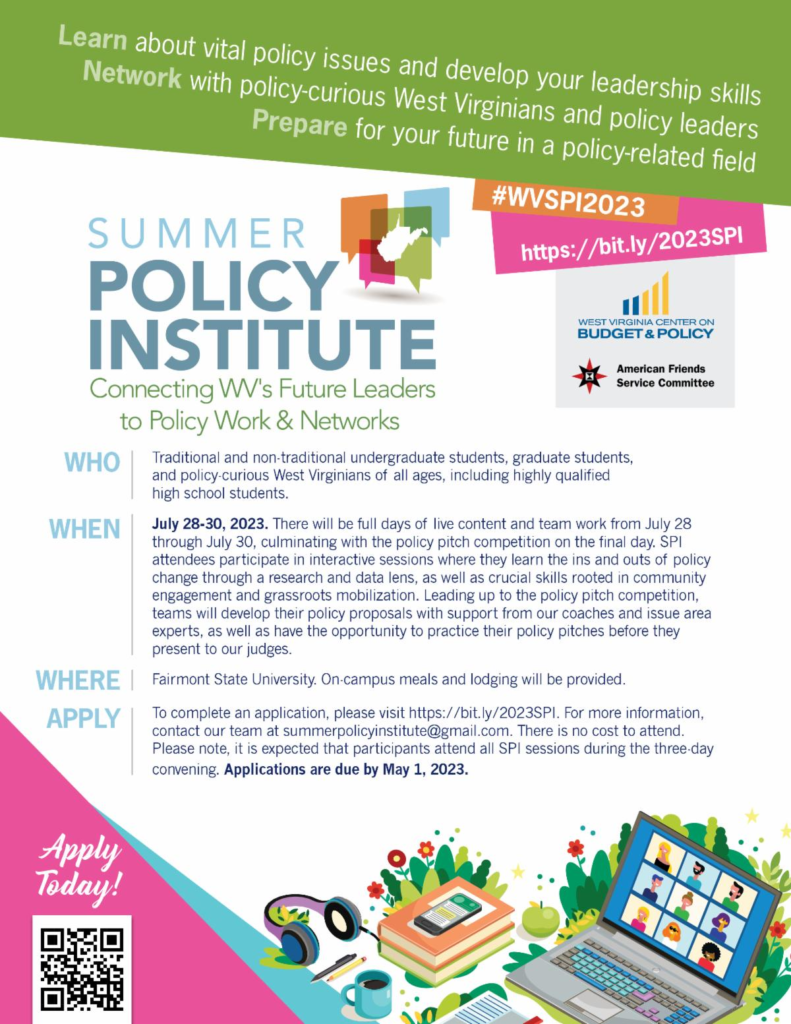The WVCBP is excited to welcome Alex Gallo to our staff as our new Community Engagement Coordinator!
Alex received a B.S. in Health Science from James Madison University, where she cultivated and deepened her passion for helping people in need. Prior to joining the Center, Alex worked with a variety of non-profit advocacy groups helping to build and lead socioeconomic and environmental justice and civic engagement campaigns. Alex is mom to Jack and they love spending time exploring the outdoors with their dog, Gaia.
We asked Alex a few questions to give her the opportunity to share about herself. Check out her answers below.
What aspect of your work at the WVCBP are you most excited about?
I am most excited about continuing to learn from West Virginians about what it would take, and what it would mean for all of us to thrive in the Mountain State. The research and analysis that the WVCBP does is so critical to advancing better policy in our state and I look forward to meeting and talking with people across the state to further improve the quality of life for all West Virginians.
What are you most proud of regarding your work prior to joining the WVCBP?
One of my most proud moments was being offered the opportunity to live and work in West Virginia. I moved here in 2015 with the intention to increase civic engagement. I am grateful to live, work, and play in the Mountain State.
What are three fun facts you would like to share with our supporters?

The latest State Job Openings and Labor Turnover Survey (JOLTS) from the Bureau of Labor Statistics showed West Virginia had the highest job openings rate in the country, with 71,000 openings. While there has been much discussion about legislation to cut unemployment benefits in an attempt to “get people back to work” and fill these job openings, unemployment benefits are not the source of West Virginia’s job openings. Instead, a mismatch of who is unemployed and what job openings are available, as well as a public sector full of vacancies, tells a more accurate story.
West Virginia’s job openings rate in January 2023 was 9.2 percent, compared to the national average of 6.5 percent. However, West Virginia also had a historically low unemployment rate of just 3.7 percent as of February 2023.
The number of West Virginia workers collecting uninsurance benefits is even lower, and also at historic lows. While 28,800 workers were considered unemployed in January, only 9,522 were considered insured unemployed, or roughly the amount collecting unemployment benefits. That is equal to only 1.2 percent of the labor force, compared to the official unemployment rate of 3.7 percent.
When comparing those insured unemployed workers with the available job openings, it becomes clear that there is a major jobs mismatch driving West Virginia’s high job openings rate, not unemployment benefits. Over 33 percent of insured unemployed workers in West Virginia are in the construction industry. However, nationwide, only 0.3 percent of job openings are in construction. Instead, professional service, health care, and food service are the industries with the greatest share of job openings, making up nearly half (49.1 percent) of all job openings in the country. In contrast, those industries make up only 15.6 percent of insured unemployed workers in the state.
The mismatch between the industries of unemployed workers and the industries in demand of workers isn’t the only explanation for West Virginia’s high job openings rate. Unfilled vacancies in state government–which both contribute to job openings and the slowing recovery in the state–are also an issue. West Virginia has recovered 98.5 percent of the private sector jobs it lost during the pandemic recession. However, as austerity budgets have taken hold and tax cuts have been prioritized over filling vacancies, the state has only recovered 90.6 percent of state government jobs and 94.5 percent of local government jobs. Overall, West Virginia is down 7,300 state and local jobs from its pre-pandemic level.
West Virginia’s ongoing population loss is also likely a driving factor. While the state’s unemployment rate is at a historic low, and its employment rate is back to its pre-pandemic level, both are influenced by the size of the population. West Virginia once again lost population in 2022, with deaths far outpacing both births and migration. With fewer West Virginians overall, it is possible to maintain a low unemployment rate while still seeing a high jobs opening rate, because there are simply fewer West Virginians overall that are available to fill jobs.
There are a variety of reasons to explain West Virginia’s high rate of job openings. From seasonal effects of construction work, to austerity policies creating vacancies all throughout state and local government, to a declining population, it is clear that unemployment benefits are not the cause. Instead of attempting to reduce access to unemployment benefits, lawmakers should focus on policies that reduce barriers to entering the labor force, including supports for families, community health, job training, and transportation.
Read Sean’s full blog post.

The West Virginia regional jail system is in crisis, with staffing shortages reaching as high as 70 percent in some facilities. These vacancies exacerbate the dangerous conditions in jails that are already severely overcrowded. Our colleague, Danni Dineen, recently published an op-ed detailing how the passage of SB 633 will help alleviate some of that overcrowding, and the urgent need to continue to work toward compassionate solutions to complex social problems like incarceration. Excerpt below:
As a first responder for people struggling in the margins, as a person in recovery and as a person who still deals with the trauma I experienced while incarcerated, I pay close attention to what West Virginia’s leadership is doing to address the humanitarian crisis in our regional jails.
Recently, a lot of the public discourse involves the staffing shortages within the Division of Corrections and Rehabilitation. The burden is heaviest for people who work in regional jails and for the people incarcerated in them.
Staffing shortages have dire consequences for the folks I serve who wind up in jail. Most of them end up there because of untreated mental illness, substance use disorder or because they simply don’t have a home. And incarceration causes further complications in their already problematic lives.
What this essentially means is that we are taking the most vulnerable people and locking them up in a cage within an environment where there’s very little capacity for care or oversight. According to recent testimony before the Legislature, Corrections currently has more than 1,000 unfilled positions.
But for our state to really address the human suffering, the deaths and the overdoses that are all too common in regional jails — in addition to dealing with the understaffing — we also must work on policy solutions that reduce the overcrowding.
With that being said, I applaud the work of the Legislature, as well as Gov. Jim Justice, for passing and signing Senate Bill 633, which deals with how capiases are handled. A capias essentially is a bench warrant for a person’s arrest.
Criminal law reform advocates like me who pushed for SB 633 are hopeful that it will help ensure fewer people sit for days and weeks in regional jail awaiting a hearing.
The new law requires magistrates and judges to set a hearing within five days of an arrest on a capias, whereas, previously, a person could be imprisoned for an indeterminate amount of time. Capias arrests are the No. 1 reason people were locked up in regional jails last year, a number that has grown 150% in the past decade.
Behind those numbers are countless stories of people whose lives are critically affected for a lifetime because of arrest and incarceration on a capias. I am one of those people.
I lost everything during the time I was incarcerated: my home and all my belongings, with the exception of the clothes on my back. I didn’t have a single diaper, baby bottle or onesie for my newborn daughter to wear. I’ve been through a lot in my life. I moved out on my own at the young age of 13, I am a veteran, I’ve survived substance use disorder, and nothing that I have ever faced in my life was as horrific and traumatizing as that experience in regional jail.
To be clear, I was arrested not because I committed a crime but for a capias that was issued for failing to report my address, and then incarcerated for months after not being given the option for a bond.
With SB 633, at least now, people won’t have to wait any longer than five days to have an initial hearing. It’s a start to address this crisis, and it’s a reminder that we also must focus on solutions that reduce the number of people who enter regional jails in the first place.
Read Danni’s full op-ed.

During the 2023 West Virginia legislative session, lawmakers passed significant tax cuts that will considerably reduce the revenue available to fund our state’s public programs and services.
Who will benefit the most from this year’s tax changes? What impact could they have on the quality of our state’s schools, libraries, health care system, and other public services and their ability to adequately serve our communities?
Join us to discuss, learn more, and have the opportunity to share how underfunding of public services has impacted you or your community.
MILTON:
BARBOURSVILLE/HUNTINGTON:
PARKERSBURG:
Please reach out to Seth DiStefano at sdistefano@wvpolicy.org with any questions!

The Summer Policy Institute brings together highly qualified traditional and non-traditional undergraduate students, graduate students, and policy-curious people of all ages to build policy knowledge, leadership skills, and networks.
SPI attendees participate in interactive sessions where they learn the ins and outs of policy change through a research and data lens, as well as crucial skills rooted in community engagement and grassroots mobilization. Attendees will meet West Virginia leaders from government, non-profit advocacy, and grassroots organizing spaces to build relationships and networks.
Throughout the convening, participants work in small teams to identify and develop policy proposals to shape the future they want to see in the Mountain State, culminating in team “policy pitches” to community leaders. Sessions will equip participants to focus on defining the problem as an essential first step before progressing to proposing solutions.
After three years of virtual SPI, we’re excited to announce that we will be returning to an in-person format for SPI 2023! The event will take place at Fairmont State University from July 28-30.
There is no cost to attend, and students can work with professors to receive course credit. It is required that participants attend all sessions during the three-day convening.
To apply, please complete this Google Form and submit your brief letter of interest to summerpolicyinstitute@gmail.com. The application deadline is May 1.
For more information, please see our event landing page.

The WVCBP’s Elevating the Medicaid Enrollment Experience (EMEE) Voices Project seeks to collect stories from West Virginians who have struggled to access Medicaid across the state. Being conducted in partnership with West Virginians for Affordable Health Care, EMEE Voices will gather insight to inform which Medicaid barriers are most pertinent to West Virginians, specifically people of color.
Do you have a Medicaid experience to share? We’d appreciate your insight. Just fill out the contact form on this webpage and we’ll reach out to you soon. We look forward to learning from you!
You can watch WVCBP’s health policy analyst Rhonda Rogombé and West Virginians for Affordable Health Care’s Mariah Plante further break down the project and its goals in this FB Live.
